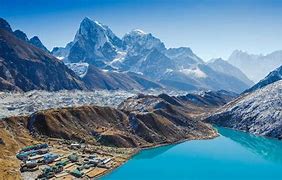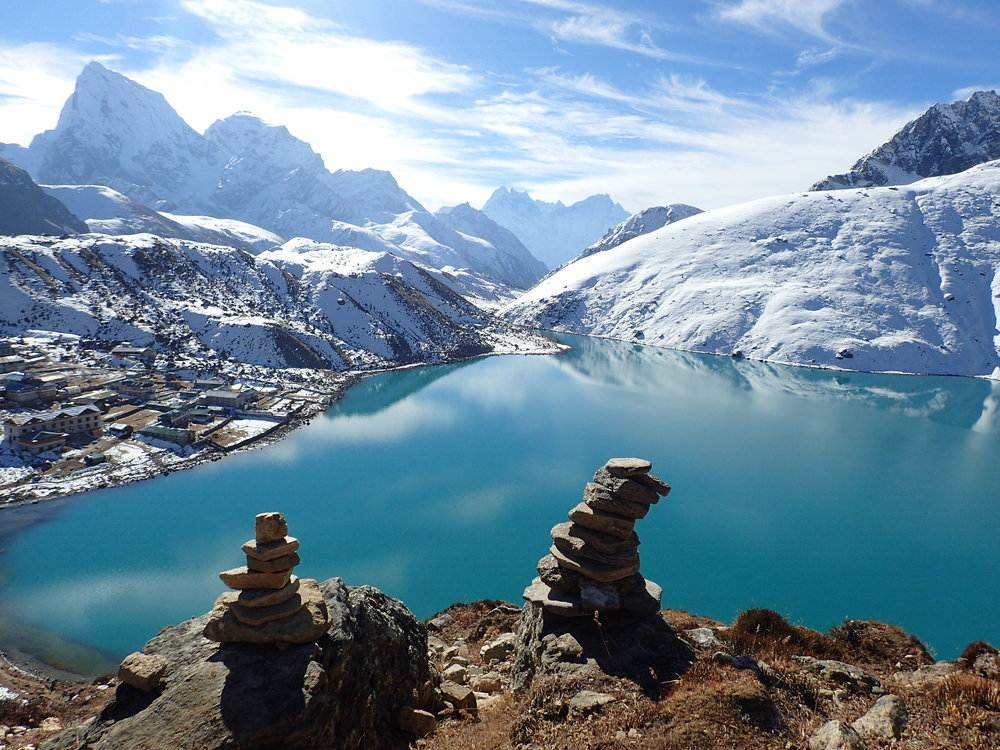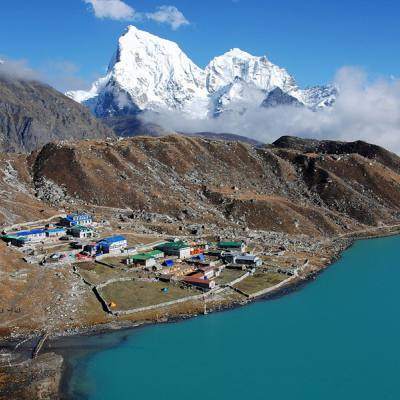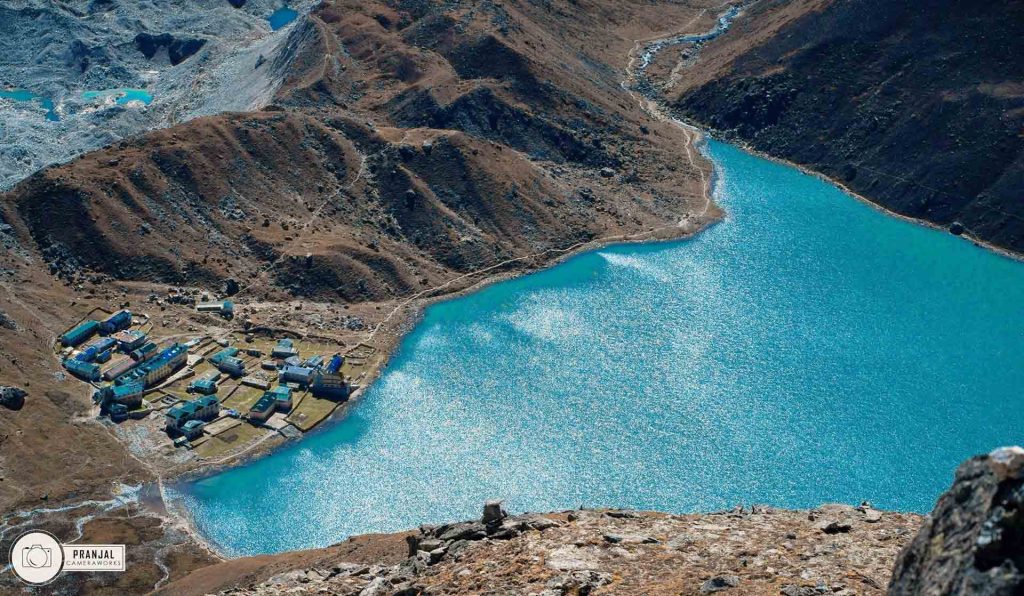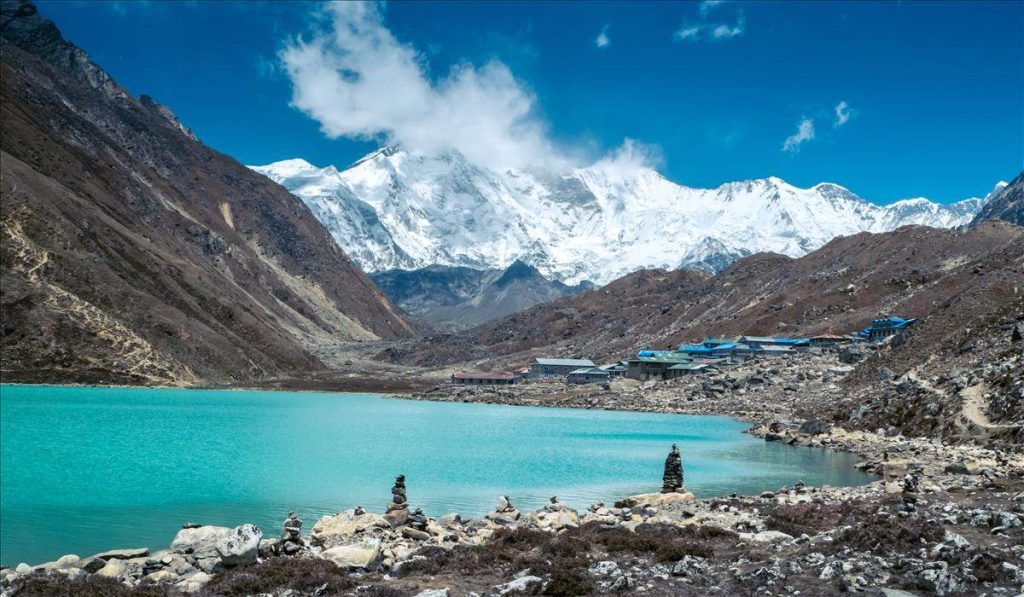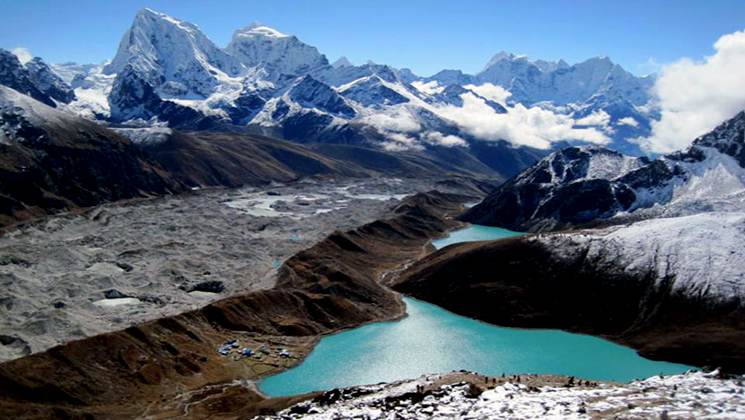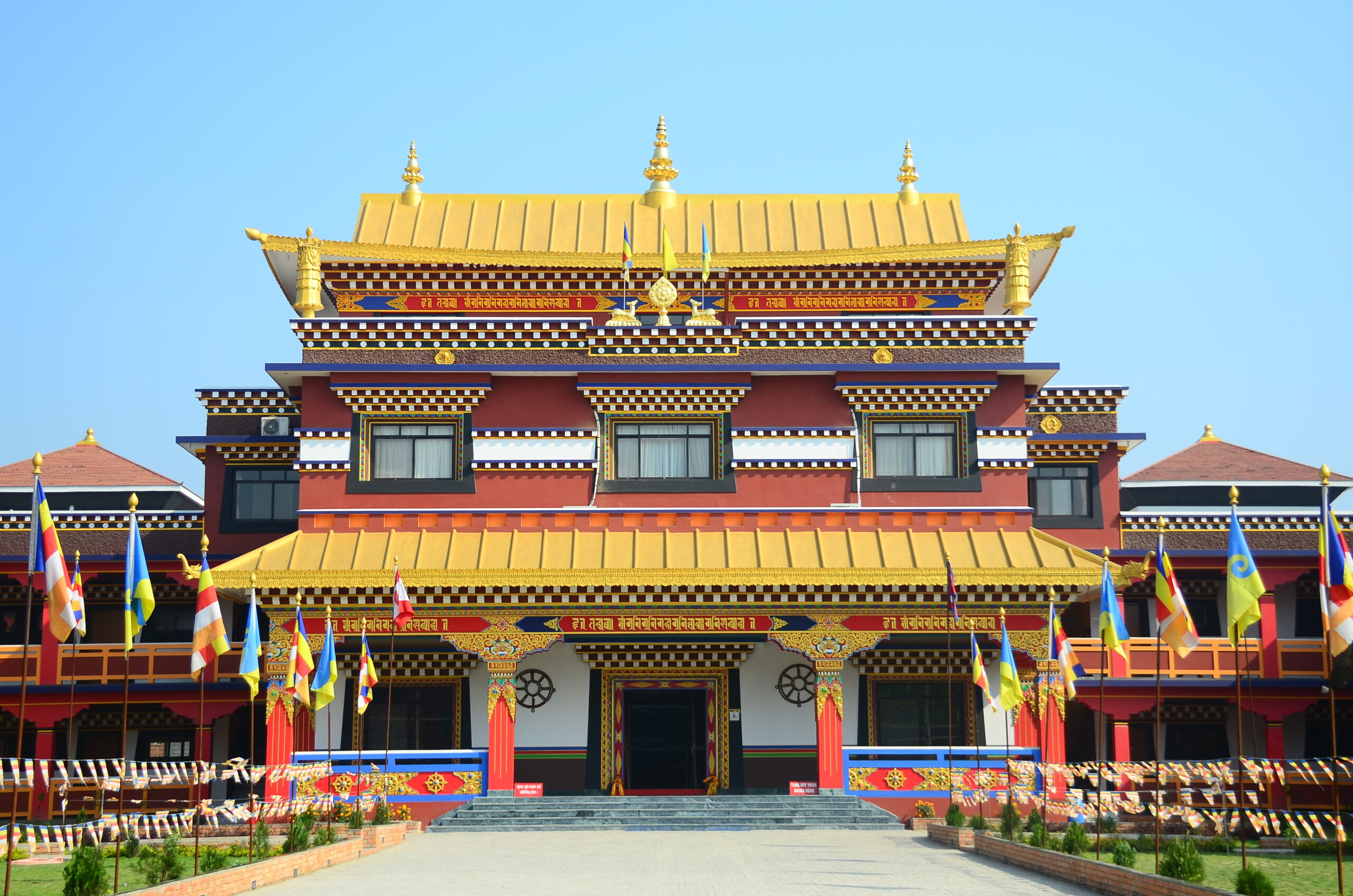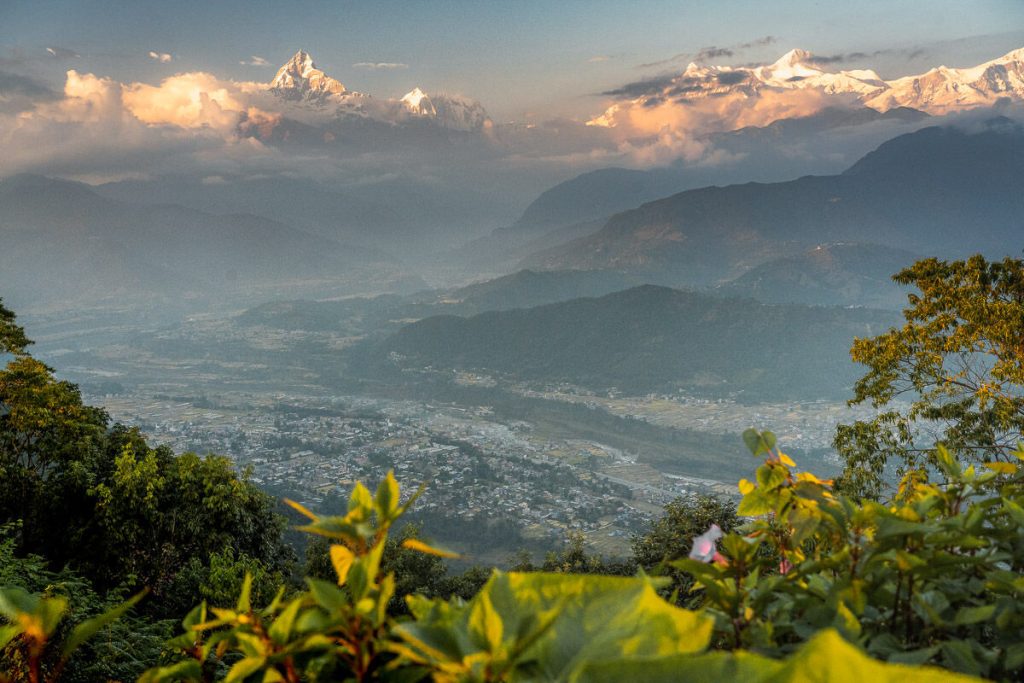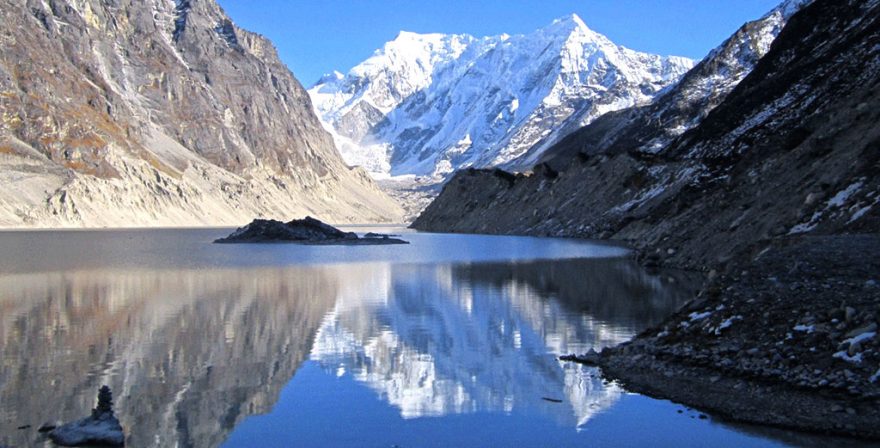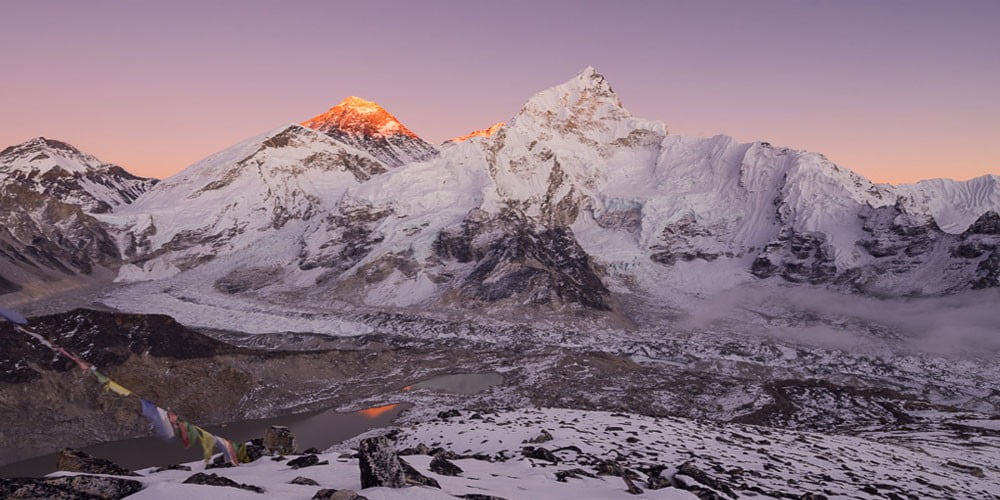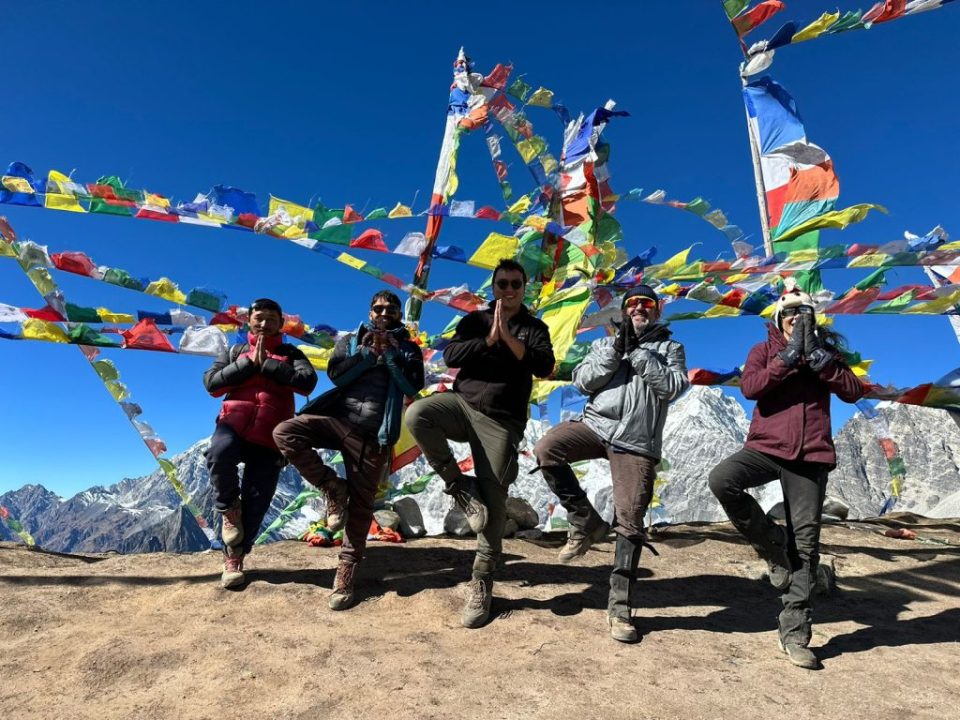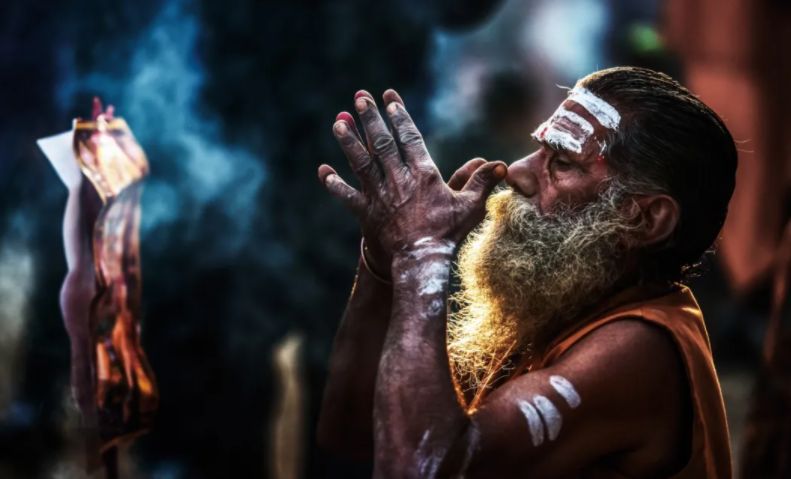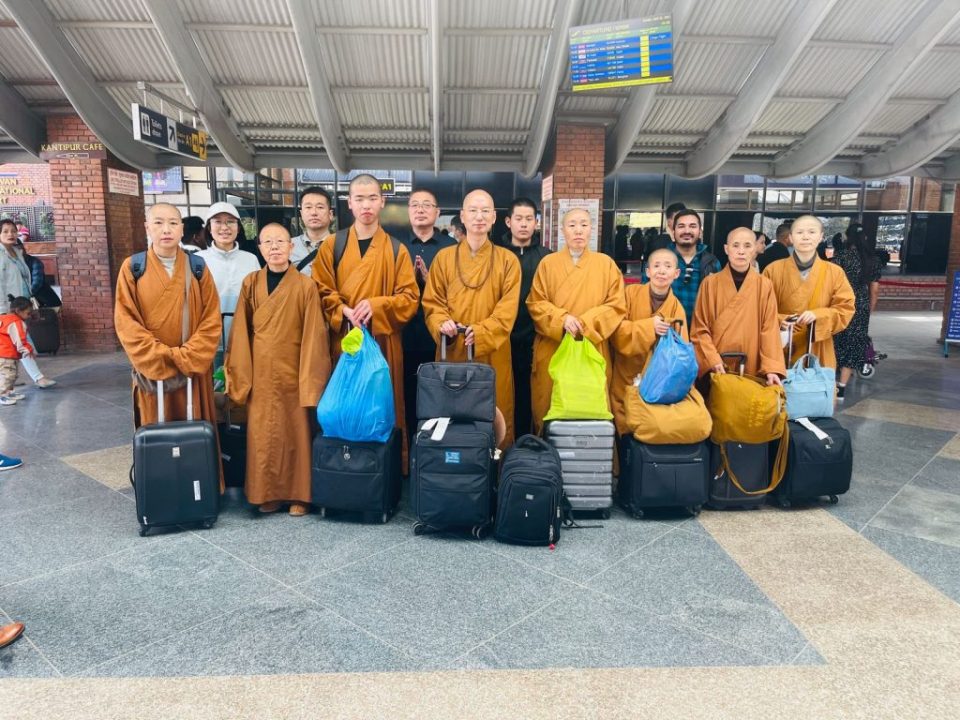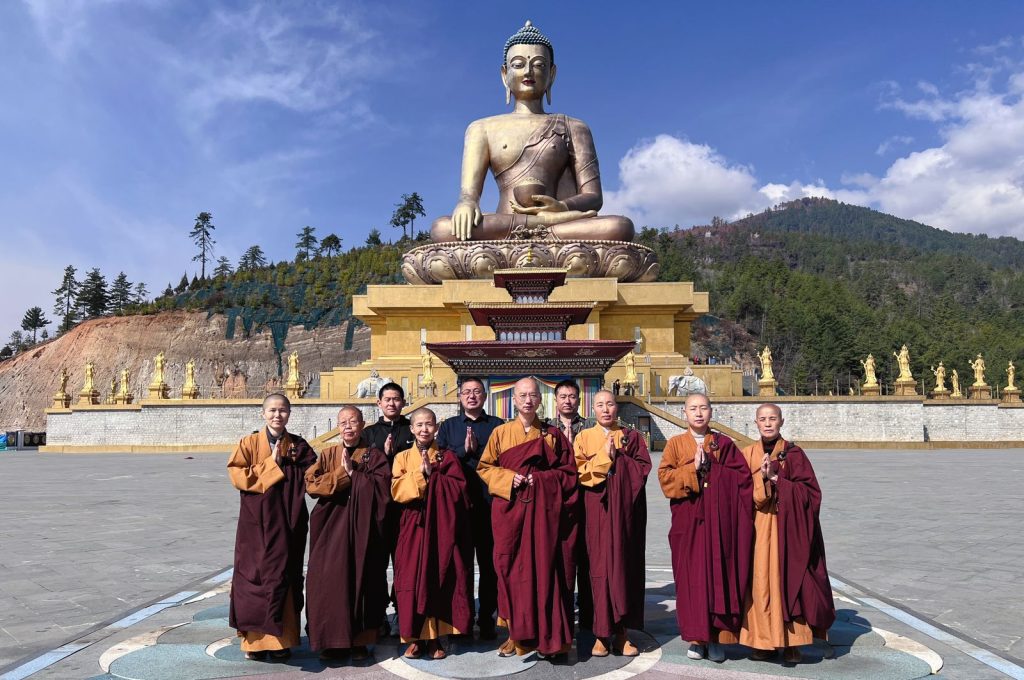Gokyo Lakes Trek
Trip Introduction
This is the ultimate aim for trekkers and adventure explorers: an amazing trek into the world’s most mountainous region. Trekking through the tough Gokyo Valley trail allows you to experience the wild and isolated nature of the Khumbu Region. Gokyo valley is one of the pictures valleys in the Everest region. Trek to the Gokyo Lakes is a trek through a unique landscape of high-altitude lakes and glaciers. Trekking above 4,000 meters takes you through some of the world’s highest human settlements. The trek follows the good path the entire way, but it can be rough and uneven at times. It is not particularly steep, and there is no rock climbing or ‘mountaineering that requires the use of equipment. Although some of the slopes can be steep and never-ending, it is a hike all the way.
The Gokyo Lakes and Gokyo Ri Trek are unique alternate Everest treks. Rather, it brings us to the blue Gokyo Lakes and Gokyo Ri, where we can see Everest and the Himalayas from afar. From Gokyo Ri, we can also see the massive Ngozumpa Glacier and the Gokyo valley. The Gokyo Lakes are a collection of six bodies of water, or lakes, located in the Gokyo Valley at an elevation of 4,700 to 5,000 meters. Gokyo Lakes are the sacred sites of both Hindu and Buddhists. The Sagarmatha National Park surrounds Gokyo Valley. You’ll walk through traditional Sherpa communities and be offered local dishes. The Dudhkoshi River is followed all the way to its source, a network of mint green lakes. The Sherpa settlement of Gokyo is situated near the 3rd lake of these lakes.
The journey truly begins after a 30-minute flight from Kathmandu to Lukla’s small airport. We spend the next few days traveling and socializing with Sherpa mountain people, staying in local lodges, and trekking into their villages’ core. On the first day of your trek, walk from Lukla to Phakding. You walk through Sherpa settlements and pine forests on a trail scattered with mani stones and mule packs. Cross suspension bridges and walk beside yak trains, which fill the peaceful mountaintop with the sound of their bells. Throughout the trek, you will be walking beside the Dudhkoshi River. We will have restful days in Namche bazaar villages, which will allow us to explore the region and acclimate, which is essential. Ascending and descending through the hills, passing the Phortse Tenga village, Dole village, Machhermo village we will reach the Gokyo valley. Climbing the Gokyo Ri and hiking to the 5th lake of Gokyo lakes we will complete our trek with the best memories of life. It is also believed that anyone visiting Gokyo for the first time, Gokyo will grant their wish, if they pray thereafter freshening up and with an empty stomach. We descend to Namche and Lukla at a slow pace after walking to Gokyo Ri (5,483 m) for our flight back to Kathmandu.
Trip Facts
| Country | Nepal |
| Destination | Everest Region |
| Duration | 14 Days |
| Accommodation | Hotel, Lodge and Tea house |
| Activity | Trekking and Hiking |
| Attraction | Gokyo Ri, Gokyo lakes, Namche Bazaar, Khumjung monastery |
| Grade | Moderate |
| Meals | 13 dinners, 13 breakfast, 10 lunch |
| Maximum Altitude | 5,357m/17,576ft |
| Best season | Mar, Apr, May, Sept, Oct, Dec |
Trip Highlights
- Scenic flight to highest altitude airport- Tenzing Hillary Airport, Lukla.
- Experience the vast biodiversity of the Himalayas by hiking through Sagarmatha National Park.
- Over 5300 meters, journey through the Secret Gokyo Valley.
- Incredible views of Mt. Lhotse, Mt. Cho Oyu, Mt. Makalu, and North face of Mt. Everest, and Gokyo valley with Gokyo lakes from Gokyo Ri, a well-known viewpoint offering a unique view of the mountain’s cape and Gokyo valley.
- Enjoy a view of sparkling blue Gokyo lakes- The highest freshwater lake system and sacred site of both Hindu and Buddhists.
- Visit Namche, the Sherpa capital, as well as Tengboche Monastery, the largest monastery in the Khumbu region.
- Get your first glimpses of the sunrise over the majestic mountains, as well as the stunning sunset.
Is this trek appropriate for you?
- This trip includes 14 days of intense trekking. You’ll be walking for 5 to 6 hours a day, at times reaching elevations above 5000 meters. We cannot underestimate the importance of being in excellent physical condition and health, which requires training before your trip to be fully prepared.
- This trek is for you if you’re seeking a demanding trekking adventure. Prior high-altitude trekking experience is recommended but not required.
- The weather in the Himalayas can be unpredictable, and every year many flights to or from Lukla are delayed or canceled because of weather conditions, so you should plan accordingly.
- The teahouses, or trekking lodges, where we stay on the trek are very basic, with just basic services. Hot water may not be always accessible and may be charged extra, as well as access to electrical outlets for charging electronics. Wi-Fi is available in some areas, although the quality of the connection may be poor.
- The route twists across difficult terrain. The highest point you’ll reach is Gokyo Ri, at 5,360 meters. Because of the weather and remoteness of this trek and the high altitude, it’s important to take it slowly and stay hydrated.
Itinerary
| Days | Activities | Duration |
| 1. | Arrival at TIA Kathmandu (1,350m/4,429ft) | |
| 2. | Fly to Lukla and trek to Phakding (2,800m/ 9,187ft) | 3-4 hrs |
| 3. | Trek from Phakding to Namche Bazaar (3,440m/ 11,280ft) | 5-6 hrs |
| 4. | Acclimatization Day at Namche Bazaar (3,440m/ 11,280ft) | |
| 5. | Trek from Namche Bazaar to Phortse (3,680m/ 14,666ft) | 4-5 hrs |
| 6. | Trek from Phortse to Machhermo (4,470m/ 14,666ft) | 5-6 hrs |
| 7. | Trek from Machhermo to Gokyo (4,800m/15,749ft) and hike to 5th Gokyo lake. | 5-6hrs |
| 8. | Hike from Gokyo to Gokyo Ri (5,360m/17,581ft) and back to Gokyo | 3-4 hrs |
| 9. | Trek from Gokyo to Dole (4090m/13419ft) | 4-5 hrs |
| 10. | Trek from Dole to Namche Bazaar Via Khumjung (3438 m / 11279 ft) | 4-5 hrs |
| 11. | Trek from Namche Bazar to Lukla (2860 m / 9383 ft) | 5-6 hrs |
| 12. | Fly from Lukla to Kathmandu (1,350m/4,429ft) | 30 mins |
| 13. | Rest Day at Kathmandu | |
| 14. | Final Departure |
Itinerary
Departure from : Kathmandu, Nepal
Arrival On : Kathmandu, Nepal
Day 1
Arrival at TIA Kathmandu
A friendly face will meet you when you arrive at TIA Kathmandu. Our agent will pick you up from the airport and transport you to your hotel. Make your way to the hotel and complete the check-in process. Our guide will meet you in the evening and give you a brief summary of the journey. Dinner and the night will be spent at the hotel.
Day 2
Fly to Lukla and trek to Phakding
Having a delicious breakfast, early in the morning, we will head to Airport for the flight to Lukla, the beginning point for the Gokyo lake trek. After a 30-minute flight with a spectacular view of Nepal’s central highlands and mountains, we arrive at Tenzing Hillary airport, Lukla. After that, we’ll meet up with the rest of our trekking team in Lukla and continue our journey to Phakding through Chaurikharka village. Phakding is a little settlement of Sherpa on the banks of the gorgeous Dudh Koshi River. We will trek through the beautiful Khumbu valley crossing the suspension bridge. We’ll arrive Phakding after a three to four-hour trek on a steep downhill trail. Dinner and overnight at a local lodge.
Day 3
Trek from Phakding to Namche Bazaar
We’ll continue forward from Phakding, we’ll check-in at the reception after breakfast and then proceed uphill into the Sagarmatha National Park. The Park is vital to the preservation of biological diversity, as well as rare flora and fauna. When we arrive at Jorsalle checkpoint we get our Sagarmatha National Park Permit. After passing the bridge at the glacial Rivers’ intersection, we must cross a high bridge i.e., Hillary bridge. We gradually climb to Namche Bazaar, the Khumbu region’s hub, and home to the Sherpa capital. Ascending at a moderate pace and passing a waterfall. The track villages are now surrounded by beautiful rhododendron, magnolia, and huge oak forests. The magnificent views of Everest, Ama Dablam, and Kongde RI cheer you up. Dinner and stay the night at a local lodge.
Day 4
Acclimatization Day at Namche Bazaar
Allow yourself a day to acclimate. Breakfast and a walk-through Namche Bazaar in the morning. Learning more about this amazing mountain marketplace is today’s interesting point of view. We can begin an acclimatization hike that takes around Namche Bazaar, around Namche Peak, and to the Sherpa Museum. Namche is the Khumbu Region’s business hub, carved out of a rocky mountainside. Luxury and cheap lodges, coffee shops, bakeries, internet cafés, ATM booths, pubs, and souvenir shops may all be found here. As we trek up the Syangboche Airport, take out your cameras to capture the amazing views of the Ama Dablam, Tawoche, Everest, Kantega, Thamserku, and the surrounding peaks. Hike up to the highest altitude hotel of world- Everest view hotel for the amazing view of Mt. Everest and other mountains. Explore around the café and restaurants, gear shops in Namche.
Dinner and Overnight stay at the lodge.
Day 5
Trek from Namche Bazaar to Phortse
After an early morning breakfast with a view, we will depart for Phortse Tenga. Today we’ll trek for roughly 4-5 hours. Way trail to Phortse Tenga from Namche is wide and well paved. On the eastern slope of the hill, we quickly ascend through rhododendron, birch, and juniper woodland. After going through many cow’s graze regions and small Sherpa communities, we arrive at the Phortse Tenga. The view from the peak of Tawoche is breathtaking. Dinner and overnight stay in a nearby lodge.
Day 6
Trek from Phortse to Machhermo
After breakfast, the trek continues with a gentle ascent to the stunning peak. The panoramic views of Kangtega and Thamserku attract us to Luza. Machhermo is reached through an uphill hike in wide trail with river on the right. The town of Machhermo is a collection of stone huts located below the Nzogumpa Glacier’s terminal moraine. You’ve made it to the 4000-meter mark. We’ll walk for roughly around 5-6 hrs then we head east to Machhermo, a village near the confluence of glacier streams, on the hillside above the river. Here, a Himalayan rescue hospital with basic treatment facilities has been created. Dinner and overnight stay at a nearby lodge.
Day 7
Trek from Machhermo to Gokyo and hike to 5th Gokyo lake.
Early in the morning, set out for Gokyo. Today’s hike will take you to a remote and ruggedly gorgeous location. You take a break while walking via Pangka to take in the breathtaking views of Cholatse. By following the trail and gradually ascending through the Ngozumba glacier’s moraine, we arrive at the riverbed. It will take about 4-5 hours to complete the trek. We pass the first lake, Longbanga Cho, then Taboche Cho, and finally the third, a sparkling blue lake Gokyo Cho, in just opposite east side of the Gokyo valley. Gokyo Cho is also called “Dudh Pokhari” which is the main lake of Gokyo Lakes.
Check- in and after short rest we will go for hike to the 5th and 4th lake of Gokyo lake (ie., Ngozumpa Cho and Thonak cho). The 5th and 4th lake of Gokyo Lakes lies in the Upper Gokyo. Walking for 2-3 hrs to the north side of Gokyo valley you will reach the 4th and 5th Gokyo lakes. In the 5 min distance in the east of Ngozumpa Cho there is Scoundrel’s Viewpoint. It is the most less visited deserted place of Gokyo valley. From there you can get the full view of 4th and 5th Gokyo lake and view of 4 highest mountains (Mt. Everest, Makalu, Cho Oyu, Lhotse) including the Tibetan side of Mt. Everest. View from this point is full of rocks and ice. Spending some time there and clicking photos head back to Gokyo valley. Dinner and Staying at a local lodge for the night.
Day 8
Trek from Gokyo to Gokyo Ri and back to Gokyo
If we trek the rough, rocky trail to the Gokyo RI early in the morning before the sunrise you will get the photogenic view. The gloomy reddish landscape gradually comes to life as the light rises. The greenish waters of the Gokyo lakes shine like a million diamonds, and snow-covered mountains turn golden. The White Mountains of the Everest region, including Mt. Everest, Makalu, Cho Oyu, Lhotse, and surrounding peaks can be seen from Gokyo RI. The north-face of the Mt. Everest, which is in Tibetan side, can also be seen from Gokyo Ri peak. In a continuous line, the Ngozumba glacier surrounds the Khumbu glacier. From this viewpoint, the 1st, 2nd, 3rd Gokyo Lakes and Gokyo valley are clearly visible. The view from Gokyo Ri is absolutely picterous. Get to work taking as many photos as you can. The hike to Gokyo Ri is just about 3-4 hrs. Then we make our way down to the Gokyo valley. Dinner and Overnight at the lodge.
Day 9
Trek from Gokyo to Dole
We will leave for the dole after eating our breakfast. We must walk for 4 to 5 hours. We’ll be walking through the shade of lovely trees. Steep and dusty, the trek is not for the weak of heart. However, the breathtaking Himalayas displaying breathtaking views are unbelievable. They’ll keep you energized. Slowly walk across the park, taking in everything you observe. Dinner Overnight at the lodge.
Day 10
Trek from Dole to Namche Bazaar Via Khumjung
We will depart for Namche bazaar early in the morning after breakfast. We’ll be walking for 4 to 5 hours. On this day, we will hike to Khumjung village, which is located at an elevation of 3,790 meters. Dole blooms spectacularly, especially in the spring, with a profusion of flowers. We will arrive in Khumjung village, which is in a secret valley influenced by Tibetan culture. In the Everest region, this is one of the most significant communities. On the way have you can have a short visit of Khumjung Monastery to see the yeti scalp which is very rare in the world. Following the trail, we will reach the Namche Bazaar. Dinner and overnight at the lodge.
Day 11
Trek from Namche Bazar to Lukla
After breakfast, we will walk through the same trail to reach Lukla. While passing through the gate of Namche, leaving the Namche Bazaar behind, you might feel some emptiness in your heart. We will rest for the day after we arrive in Lukla. Have a get-together with the local crew in the evening to celebrate the end of your Everest trip. Dinner and overnight at the lodge.
Day 12
Fly from Lukla to Kathmandu
Following breakfast. Return to Kathmandu by checking out of the lodge. It’s the time to say goodbye to the gorgeous mountains, lush forests, and your travel mate. Our agent will meet you at the Kathmandu airport and transport you to the hotel. Make your way to the hotel. You are free for the rest of the day. You may take a walk in Kathmandu’s valley and a night stroll through Thamel. Kathmandu offer you many things to do and many places to visit. Spend the night in the hotel.
Day 13
Rest Day at Kathmandu
Today is your last day in Kathmandu and your relaxation day. You are free to do whatever you choose with your day. You are free to walk through Thamel and Basantapur streets as much as you wish. Enjoy a complimentary farewell supper at a traditional Nepali restaurant later that evening.
Day 14
Final Departure
Our agent will drive you to the international airport of Kathmandu 3 hours earlier than your flight time, as per your travel itinerary, and your tour will end here.
Route Map
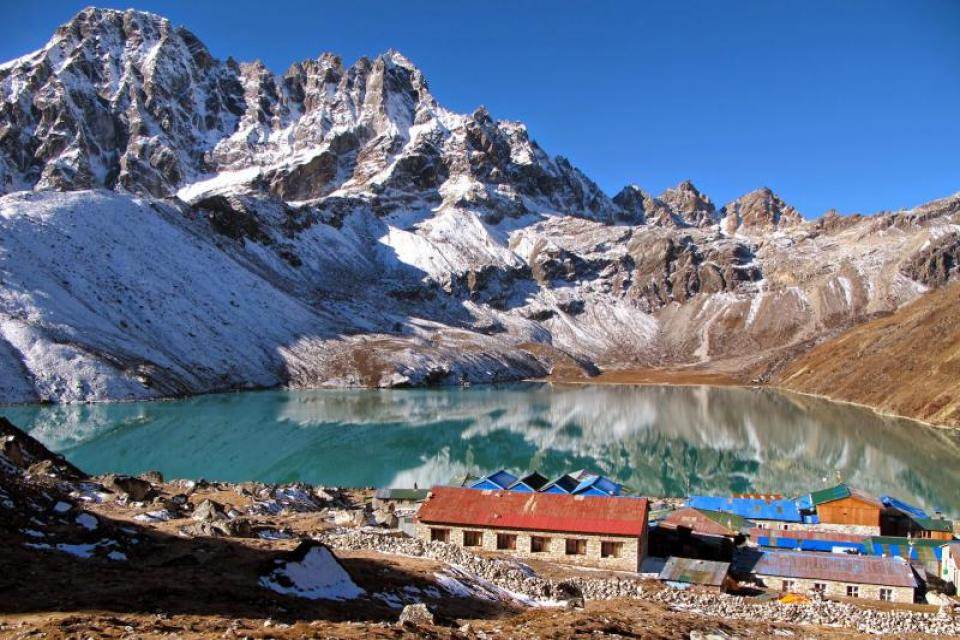
Altitude Map
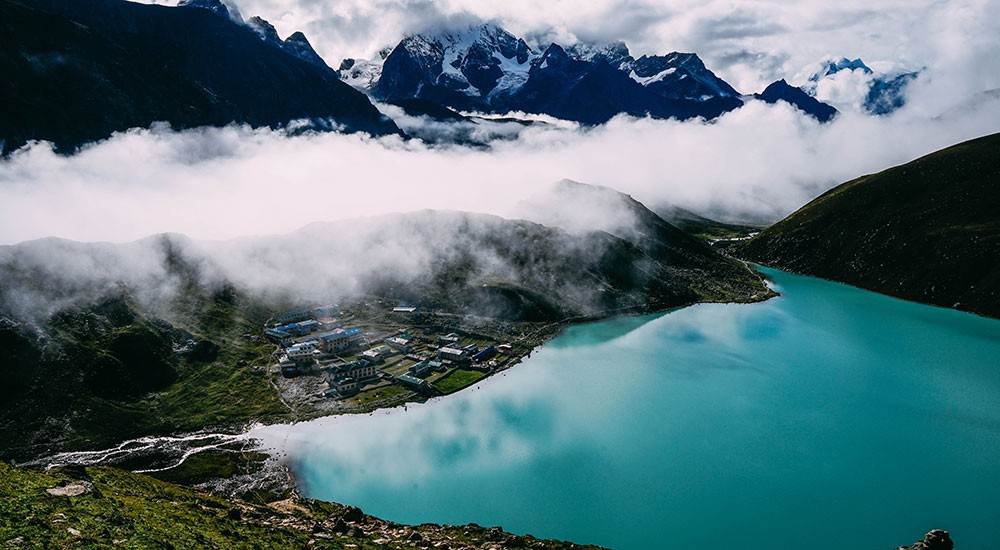
What's Included
- Arrival & Departure: Airport – Hotel transfer – Airport (Pick Up and Drop).
- Hotel Accommodation in Kathmandu: 2nights at Star categories hotel on twin sharing on bed and breakfast basis.
- Welcome Dinner and farewell dinner at Nepali culture restaurant in Kathmandu with Office’s Staff.
- Food & Lodging: 3 meals a day (BLD; including tea and coffee) along with accessible accommodation sharing at Hotel/Lodge/teahouse during the trek.
- Permit: All necessary paper works: Sagarmatha National Park permit & Khumbu Rural Municipality entry fee.
- All government and local taxes if necessary.
- Trekking Map: Everest Region Trekking map.
- Member transportation: – Air Transportation: (Domestic Flight) Fly from Kathmandu – Lukla and while returning Lukla.
- Drinking water: 2 liters of boiled water to carry on thermos per day per member.
- Guide: Government licensed Guide (English speaking) during the trek
- Porter: Porters (2 trekkers: 1 porter) up to 15kg during the trek.
- Insurance: Insurance for all involved Nepalese staff during the trek.
- Comprehensive Medical kit.
What's Not Included
- Air Fare: International flight airfare (from and to Kathmandu).
- Nepal entry Visa fee: Nepalese Visa fee per person 30 USD for 15 days, 50 USD for 30 days and to be applied for 90 days 125 USD.
- Extra night in Kathmandu: Extra nights’ expenses in Kathmandu. In case of early arrival or late departure, early return from Trekking (due to any reason) than the scheduled itinerary.
- Personal Insurance: Travel and high-altitude insurance. *Mandatory
- Personal Expenses: Telephone calls, Internet, Toiletries, battery recharge, hot shower, laundry, soft drinks, beer, and any alcoholic beverages.
- Personal Equipment: Clothing, Packing Items or Bags, Personal Medical Kit, Personal Trekking equipment.
- Rescue Evacuation: Medical and emergency rescue evacuation costs if required. (Rescue, Repatriation, Helicopter, Medication, Medical Tests and Hospitalization costs).
Equipment List
What to bring ?
General
Tailor Your Holiday
Everyone has their own preferences in terms of destination, journey time, and budget. As a result, sticking to our plan isn't necessary. We will create a personalized itinerary for you that includes accommodations, transportation, meals, and tour guides. We guarantee you the best Tailor-made Package because this is your trip. You have the option to personalize it, as your liking. Let us Plan together to make your Vacation worth it.
Fixed Departure
Why Travel With Us?
Secure Online Payment, No Credit Card Fee
Travel with Locals. Support Locals
Lifetime Deposit
Private & Tailor-Made Trips
24/7 International Support
Support Local Communities & Donate to Charity
All Inclusive Price
Secure Online Payment, No Credit Card Fee
The ideal season to travel
January:
Nepal’s trekking off-season is in full effect in January, with low tourist numbers across the nation. The spectacular views and the fact that you’ll have the trails to yourself make this a surprisingly fantastic time to walk across the Gokyo Lake if you’re prepared for chilly temperatures.
February:
While much of Nepal remains freezing in early February, the temperature begins to rise later in the month. The mountains are still cold, and there will be snow, but winter is coming to an end. The average February temperature in Namche Bazaar (11,290 feet/3440 meters) is 43°F (6°C), which isn’t too cold but certainly not warm. Since winter is the off-season, finding a bed in the teahouses that are open throughout the Everest region should be simple.
March:
March marks the start of spring, one of Nepal’s two high seasons. While temperatures in the mountains will likely remain chilly, and snow will likely remain in certain areas, pathways will begin to soften. In March, trekkers returned in greater numbers, and there are numerous reasons for this. While March isn’t as crowded as April, the normal Everest Base Camp (EBC) route soon overflows during this season. Crimson rhododendrons can be seen in March month.
April:
April, as of March, is a popular trekking month in Nepal. The monsoon rains are still some weeks away, and temperatures are normally pleasant or at least not too chilly in the high Himalayas. In April, temperatures in the Himalayas are still cooler: 34°F (1°C) to 53°F (12°C) in Namche Bazaar (11,290 feet/3440 meters), an important destination on the EBC climb. At higher elevations, temperatures will be cooler. As the Everest region is the region of Buddhist culture, you can get to see the pictures of is buddha Jayanti celebration in the monasteries, which falls at the end of April.
May:
May marks the beginning of the Everest climbing season, as weather conditions on the mountain are most ideal at this time of year, although these conditions are very different from what normal trekkers will find at lower altitudes. Although the number of trekkers in Nepal decreases in May as humidity and temperatures rise in preparation for the monsoon season, the trail to EBC is an exception. For the nature lover, May and June is the best time to trek.
June:
By mid-June, monsoon rains had arrived, and most trekkers had left the paths. The conclusion of the Everest-climbing season normally occurs in the first half of the month. However, even once the rains begin, it hardly ever rains all day every day, so if you’re prepared for rainy weather and understand that humidity and rain clouds may hamper your views, June isn’t a bad month to trek in the Everest Region. Furthermore, the higher you climb in height, the less probable it is that it will rain.
July:
In July, Nepal’s high rainfall keeps most trekkers off the trails. However, individuals who are well-prepared with good rain gear and are willing to accept some potential travel delays can still enjoy their climb to Everest Base Camp. In July, the temperature in Namche Bazaar is pleasant, with an average high of 60°F (16°C). The further you travel into the mountains, the cooler it gets and the less rain you get, however, it will almost surely pour at lower elevations. There’s also a danger of mudslides and landslides disrupting hiking trails. The most important festival of Sherpas, “Dumji festival” falls during the end of June or early July.
August:
The monsoon season in Nepal begins in mid-June and lasts until mid-September. In July and August, the Everest Region, like the rest of the country, receives the most yearly rainfall. It also has the hottest temperatures; while the high Himalaya is never ‘hot,’ normal highs in August in Namche Bazaar are around 60°F (16°C).
The higher you go into the mountains, the cooler it gets and the less rain there is. In August, there’s also a danger that landslides would close hiking routes and make paths muddy.
September:
By mid-to-late September, the monsoon rains will have passed, and the weather will be suitable for trekking in Nepal once more. Even though excessive humidity may hide some mountain views, there’s still a possibility to see amazing views early in the morning. In addition, in September, the popular Everest region trek is less crowded than later in the autumn season.
October:
The month of October is the busiest for trekkers in Nepal. The weather is quite stable, with a clean, rain-free sky providing superb mountain views. However, crowds are at an all-time high, with the Everest region Trek being the most popular in the country. When visiting the Everest region in October, it is critical to plan properly far ahead as possible. In late Oct or early Nov the full moon, people in the Everest region celebrate the famous 19 days long colorful festival “Mani Rimdu” in Tengboche Monastery, but the last 3 days of this festival is only open for the public.
November:
In November, there is extremely little possibility of rain in the Everest region—it is the driest month of the year. This means that humidity is at an all-time low, and the chances of seeing Clear Mountain views are greater than at any other time of year. Temperatures are a few degrees lower than they were in October, with a low of 26°F (-3°C) in Namche Bazaar (11,290 feet/3440 meters) with a high of 48°F (9°C) on average. Temperatures will be even cooler at higher elevations. However, given the low chance of rain and clear skies, November is the greatest month of the year to hike to Everest in terms of weather.
December:
As winter approaches, the trekking trails become empty except for the most courageous adventurers. However, if you’re properly equipped for cold temperatures, December is a great season to walk to Everest Base Camp. The weather in December isn’t quite as freezing as it is in January, but the difference isn’t significant. This month, the average high in Namche Bazaar is 44°F (7°C), while the average low is 21°F (-6°C). Because Namche is only 11,290 feet (3,440 meters) above sea level, temperatures will be much cooler higher up.
Flight to Lukla
Almost every trip begins with a flight from Kathmandu to Tenzing Hillary Airport in Lukla, a small single-landing runway airport high in the Himalayas. As it is the easiest way for your trek to Gokyo trek.
- Lukla Airport is also known as the most dangerous airport in the world. This airport, which is only open when the weather is calm, and visibility is excellent.
- The Flight from Kathmandu to Lukla is about 30 min and the flight from Manthali to Lukla is about 20-25 min. Flight from Kathmandu to Lukla through helicopter is about 45 min.
- It’s impossible to say whether your Lukla flight will be canceled or not. If this occurs, your trip may be extended by one or two days. So, plan and add buffer days to your itinerary to ensure you don’t miss your international flight.
- Flights to and from Lukla are currently operated from Manthali Airport in Ramechhap rush hours at Kathmandu Airport during the high season (spring and autumn). Kathmandu is 132 kilometers (4 hours and 30 minutes) away.
- Helicopters have a little more flexibility when it comes to arriving at Lukla and can frequently make the flight in weather or visibility that a small plane would not be able to make. It is sometimes doable to switch your flight to a helicopter, but this can be expensive and there is no guarantee that you will arrive on time.
Altitude sickness
Altitude sickness is a sneaky monster that may attack even the fittest trekkers. These demands do take everything in your power to prepare for altitude trekking and taking things carefully throughout your Everest region journey. With increasing altitude, the amount of available oxygen decreases, which is the primary cause of high-altitude sickness. Gokyo is located at an elevation of over 5000 meters above sea level, where the atmosphere is depleted of oxygen, the air is thin, making breathing difficult.
The Gokyo Lakes Trip is a high-altitude trek that needs proper acclimatization. Your body requires time to adjust to thin air, so start at a lower altitude and work your way up. Some of the symptoms of Altitude sickness are:
- Increased breathing.
- Increased urination.
- Restless sleep.
- Periodic breathing at night because of altitude.
- Dehydration.
- Shortness of breath.
- Extreme fatigue.
- Respiratory failure.
- Cerebral edema.
- Coma.
Certain care should be made to ensure that the situation does not worsen. However, if the symptoms worsen, you may need to return to a lower height and seek medical help. There are, however, several other precautions you may take while trekking in the Everest region to lessen your risk of altitude sickness.
- Trekkers can modify their bodies by slowly and gradually climbing, as our bodies require time to adjust to the oxygen level. At least one day of acclimatization rest is required for high altitude trekking, and you should go as high as possible before returning to a lower height for the night.
- You should do various strength training exercises such as running, cycling, jogging, push-ups, and going to the gym to acquire strength and stamina for your adventure.
- As the air gets increasingly thin, an increase in elevation reduces oxygen levels, and in the Everest region trek, an increase in altitude also means less vegetation. The consumption of alcoholic beverages, cigarettes, and tobacco decreases the body’s water content.
- The greatest remedy is to always stay hydrated. On your walk, instead of drinking cooled water, drink warm water.
- Diamox is the most effective altitude sickness medication; thus, you should bring a subscription with you on the trek. However, you should consult with your physician to see whether it is advantageous.
Things to know before traveling to Gokyo Lake
Drinking-Water
Especially for trekkers, it is very necessary to hydrate your body at a higher altitude than in lower elevations to avoid dehydration and altitude sickness. Lack of fluid can be the main hindrance during the trek. You should hydrate your body with at least 3-4 liters of water daily (Tea, soup, or normal drinking water). Throughout the trek, you will come across tap and spring water, but it is not safe to drink without purifying it. You can buy the plastic bottle water in the teahouses but get expensive as you climb in the higher altitude, and it causes pollutes the local ecosystem, therefore we recommend you to use a Reusable water bottle or water pouch favorable for both hot and cold water.
During this trek, you may have to pay from 1$ to 5$ (at Gorakshep) for a sealed bottle of water. Here are some ways that you can use to make the water drinkable.
- Boiled water
Boiling water is the best way to purify the water. As we are climbing to a higher altitude you need to boil the water for about 3-minute and season it with a pinch of salt before drinking. You can get free cold water in the teahouse but for boiled water, it cost around 1-2$ per liter and 3$- 10$ for a large pot.
- Purification tablets or electrolyte powder.
Purification tablets like chlorine or iodine tablets are commonly used tablets by trekkers to disinfect the water. 1 tablet is enough for a liter of water. It takes around 30 min for the tablets to dissolve and become drinkable. Water,do take purify by tablets may leave a taste in your mouth.
Electrolyte powder is another option. Electrolyte powder is a better way to purify water than tablets because electrolyte powder contains minerals such as salt, Potassium, Magnesium, which are important for your body during the trek.
- UV Light water purifier/ SteriPEN.
It is a simple, effective, economic, and environment-friendly way to purify water. It kills the bacteria and virus within 10 sec by exposing them to ultraviolet light using Steripen, without changing the flavor of the water. This is a highly recommended method of purifying water.
Essential Backpack items for Gokyo lake Trek.
The bag of a trekker also reveals the trekker’s level of experience. A good trekker should be a smart backpacker. You should be pre-prepared for the things that you need in the trek.
Here are some of the things that you need to take with you for the trek.
Travel documents
- Airline tickets with the itinerary.
- Travel insurance policy documents.
- Valid passport.
- Copies of passport.
- Passport-sized photos.
- Nepalese cash.
- Travel permits.
Clothing
- A pair of waterproof trekking shoes or hiking boots.
- A pair of flip flop slippers or running shoes.
- 2 sets of thermals (leggings and tops)
- 3-4 pairs of hiking long sleeve shirts or tops.
- Pairs of hiking shorts and pants.
- Fleece jumpers or a set of tracksuits.
- Good quality windproof down jacket.
- Lightweight waterproof rain jacket and pants.
- Neck gaiter, leg warmer, and packet of pocket hand warmers.
- 4-5 pairs of quick-dry socks, underwear, and sports bra.
- Pair of inner and outer gloves.
- Knitted Hat, sun cap, beanie, or bandana.
- Glacier Sunglasses and eyeshade.
Trekking equipment
- Waterproof trekking bag of 40-50liter and Rucksack of duffel bag (if your backpack is not enough for all your item and need a potter).
- Reusable water bottle (both hot and cold) of at least 1-2litre.
- A sleeping bag and sleeping bag liner.
- Trekking stick/ poles.
- Crampons (if you are trekking in the Winter season, Jan-Feb)
- LED Headtorch or solar lamp (LuminAID lamp).
- Stuff sacks, plastic bags.
- Plug adapter, Charging appliances, power bank, batteries.
- Pocket knife.
- Travel Wallet.
Toiletries
- Rolls of Toilet paper, wet wipes, and tissue.
- Medium-sized quick-drying towel.
- Toothbrush and toothpaste.
- Hand sanitizer.
- Sunscreen, lip balm, body lotions.
- Deodorants.
- Portable mirror.
- Shampoo and soap.
Personal First Aid Kit
- Antibiotics
- Painkillers, Paracetamol, ibuprofen, aspirin, Nicole
- Sanitary pads
- Bandage.
- Anti-inflammatory spray.
- Anti-Nausea tablets.
- Anti-diarrhea pills or power.
- Altitude sickness tablets.
- Water purifying tablets or electrolyte powder.
- Mosquito and Insect Repellent
- Salt or anti-leech oil (If traveling in rainy season, July- Aug)
- Earplugs
You can buy or hire trekking clothes and equipment in Kathmandu. If you are buying it, you have to allow an extra day for shopping; however, if you are hiring it, you must inform us in advance so that we can arrange it before you arrive in Kathmandu. This way you can reduce the weight of your luggage and save time and money.
Branded trekking clothes and equipment are available around the Thamel area at a reasonable price.
Note- Kathmandu- Lukla flight has a luggage allowance of 15 – 20 kg per person. For extra baggage, they charge 2$ – 3$ per kg. So, you can wear your trekking boots and jacket to reduce the weight. Have a hand carry bag for your passport, money, medicine, and a pair of clothing. You can leave some unnecessary items in a hotel in Kathmandu also.
Accommodation, Meal, and Transportation
Accommodation
We will accommodate in star hotel during our stay in Kathmandu. In Lukla, Phakding, and Namche Bazaar we will stay in lodges. For the rest of the stop, we stay at teahouses.
Meal
During the trek, we will provide you three-time meals. You can choose from the given menu.
Breakfast– French toast, Cornflakes, Cereal, Pancakes, Bread butter, Eggs, Oatmeal, Porridge, Tea, etc.
Lunch– Dal Bhat (Rice, vegetable curry, meat curry, Lentils, Tomato Chutney, Salad, Papad) Vegetable noodle soup, Chicken noodles soup, Garlic soup, Fried noodles, Fried rice, Thukpa, Fried potato, Mo: Mo, etc.
Dinner– Dal Bhat (Rice, vegetable curry, meat curry, Lentils, Tomato Chutney, Salad, Papad) Vegetable noodle soup, Chicken noodles soup, Garlic soup, Fried noodles, Fried rice, Thukpa, Fried potato, Mo: Mo, etc.
Besides these, there are a variety of other options of food. You can buy it from your pocket.
Transportation
By Bus- from Kathmandu airport to hotel at Kathmandu and vice-versa.
By Air- Flight to Nepal.
Flight from Kathmandu to Lukla and back.
A typical day on the Gokyo lake trek
Every day will begin with the ringing of your alarm clock at 6 a.m. and a knock on your door from your guide with the invitation of breakfast. Get up, have breakfast, pack your backpack and get ready to start your day’s walk by 7 a.m. We need to start our trek early to avoid the scorching sun as in midafternoon the wind gets stronger compared to morning in higher altitudes.
You’ll wander along the trail enjoying the scenery, clicking photos, creating memories, passing by other travelers, interacting with your guide, hearing each other’s stories. Lunch will be served at a local teahouse in the late afternoon (1-2 am). Having lunch and an hour of rest, we will proceed to the day’s final destination as per the itinerary.
On arrival at the destination, check into your accommodation. Get freshen up and some rest. As every teahouse where we stay has a large common dining area with a wood-burning stove in the center, there you will get to meet other travelers. You can sit there, laugh at each other stories, play cards, sing songs, play music, and have a good time. This will help you forget all the tiredness of the day. Later in the evening, you will have your dinner together. After dinner, your guide will give a short briefing about the next day’s trek regarding when you must get up when we have to start our trek the next day, where we will stay the next day, how many hours we have to walk, and so on.
During the acclimatization day, hike around the small peak or viewpoints. At night enjoy the view of sparkling stars floating in the clear sky above the cold wind. The pristine blue and green water of Gokyo lakes, colorful magical sunset, and mountains view from Gokyo Ri, the reflection of Ama Dablam in Cholachen lake, View of 5th and 4th lake from Scoundrel’s viewpoint will be your lifetime memory. Every stop might not be iconic but these 14 days trek of Gokyo lakes trek via. Gokyo valley will give you unforgettable emotions. Your hard walk will be paid off on reaching the destination with lifelong memories.
Nepal Tourist Visa and permits details
Visa procedure.
To travel to Nepal, you’ll need a tourist visa that is valid for the period of your stay in Nepal. Better, if you have a tourist visa valid for at least 2 months because anything can happen during the trip, and staying in Nepal after your visa expires would result in you paying a penalty. Apply for a visa at your nearest Embassy of Nepal or obtain an On-Arrival visa at immigration in Tribhuvan International Airport, Kathmandu. But it’s better to contact your nearest Nepalese Embassy.
Here are the documents that you need, to apply for the tourist visa.
- The Tourist Visa Application Form for Nepal (Fully completed online and printed)
- Original Passport with at least 2 blank pages and validity of at least 6 months.
- Photocopies of your passport’s information page.
- At least 2 recent passport-sized photos of yourself with white background.
- Proof of accommodation in Nepal.
- Valid travel and return flight tickets.
- A bank statement from the last 3 months with a minimum closing balance of NPR 2, 00,000.
- Receipt of the visa fee for Nepal.
Note: 15 days visa cost USD 30 but our trip is of 14 days. So, apply for 30 days tourist visa that costs USD 50 so that you can spend some more time in Nepal. For 90 days visa costs USD125.
Entry permits and Requirements
As Gokyo lakes and Gokyo valley come under the management of Sagarmatha National Park, which is conserved by the government, so you need an entry permit to trek through this area. The entry permits that you need for this Gokyo lakes trekking of the Everest region are
| Trekking permits | Foreign Nationals | SAARC nationals | Nepali Citizens | |
| 1 | Khumbu Pasang Lhamu Rural Municipality Entrance Permit | NPR 2,000 per person (for the first 4 weeks)
NPR 2,500 per person (beyond 4 weeks) |
NPR 2,000 per person (for the first 4 weeks)
NPR 2,500 per person (beyond 4 weeks) |
NPR 2,000 per person (for the first 4 weeks)
NPR 2,500 per person (beyond 4 weeks) |
| 2 | Sagarmatha National Park Permit | NPR 3,000 per person per entry + 13% vat.
(Approx. 34$) |
NPR 1,500 per person per entry +13% vat
(Approx. 15$) |
NPR 100 per person per entry +13% vat
(Approx. 1$) |
Note A Khumbu Rural Municipality Entrance permit must be obtained from the Rural Municipality desk at the Lukla checkpoint.
Permits for the Sagarmatha National Park can be obtained from the Nepal Tourism Board in Kathmandu and the Sagarmatha National Park entrance gate at Monjo. To save time, we recommend that you obtain a Sagarmatha National Park Permit in Kathmandu.
For more information about Trekking Permit here is the link.
(If you are traveling from a travel/trekking agency your agency will arrange all the Permits.)
Documents required to get the Trekking permits.
- Complete the form with your passport details.
- 2 Passport size photo.
- 2 Photocopy of passport valid for at least 6 months.
For more information contact us.
Travel Insurance
Trekking in Nepal is an adventurous and occasionally dangerous activity, especially at high altitudes. Trekkers must have travel insurance before visiting Nepal for trekking. During this 14 days trek to Gokyo Lake trek you might come across some physical injury, illness, a sudden accident during the trek and you will be responsible for all medical expenses and losses.
So, you need to have travel insurance that will cover all our risk up to the altitude of 5,360 m (Gokyo Ri).
You need to choose an insurance policy that covers all of your possible risks from the start of your journey to your final destination. The following threats should be covered by your travel insurance:
- Cancellation of Domestic and International flights.
- Lost and stolen baggage and passport.
- Hospital and Medical expenses (physical injury, Acute Mountain sickness, Altitude sickness, sudden accident)
- Emergency rescue such as Helicopter.
- All high-altitude trek dangers up to 5,600m.
- You need to choose your travel insurance wisely so that, in the case of such an incident, your travel insurance will cover the costs.
You need to buy your travel insurance wisely so that if in case you come across any such incident, your travel insurance will bear it.
You can have your travel insurance in your home country or Nepal also.
Travel Insurance
Trekking in Nepal is an adventurous and occasionally dangerous activity, especially at high altitudes. Trekkers must have travel insurance before visiting Nepal for trekking. During these 14 days trek to Gokyo Lake trek you might come across some physical injury, illness, sudden accident during the trek and you will be responsible for all medical expenses and losses.
So, you need to have a travel insurance that will cover all our risk up to the altitude of 5,360 m (Gokyo Ri).
You need to choose an insurance policy that cover all of your possible risks from the start of your journey to your final destination. The following threats should be covered by your travel insurance:
- Cancellation of Domestic and International flights.
- Lost and stolen of baggage and passport.
- Hospital and Medical expenses (physical injury, Acute Mountain sickness, Altitude sickness, sudden accident)
- Emergency rescue such as Helicopter.
- All high-altitude trek dangers up to 5,600m.
- You need to choose your travel insurance wisely so that, in the case of such incident, your travel insurance will cover the costs.
You need to buy your travel insurance wisely so that if in case you come across any such incident, your travel insurance will bear it.
You can have your travel insurance in your home country or in Nepal also.
Responsible Travel
As the Everest region is not only the gateway to Mount Everest but is also the homeland of Sherpa. Besides being called the mountainous region, the Everest region is also known for the Sherpa’s traditions, cultures, Tibetan culture, and eco-friendly environment.
Gokyo valley is also one of the most popular destinations of the Everest Region because of the world’s highest freshwater lake system i.e., Gokyo lakes, located in Gokyo valley. Gokyo lakes have both natural, religious, and spiritual importance. All travelers should travel responsibly in these regions. Majority of People in the Everest region practice Buddhism and Tibetan culture. You have to respect the local people, their culture, and religion and try to limit any negative activities that will impact their local culture and environment. You can learn some Nepali greetings words to greet them respectfully.
We expect you to properly dispose of the plastic garbage (food wrappers, plastic water bottles). You might encounter many rare species on the way to Gokyo valley, you rather not disturbed them. While visiting the monasteries follow the monastery’s norms. Ask for permission before entering and to click photos in any monasteries. The people of the Khumbu region are always at threat of the outburst of Ngozumpa Glaciers. Your one small negative impact can make a big impact on them and their daily life.
Your responsible travel will help Nepal achieve long-term sustainable tourism
Guide and Staff Arrangements
Throughout the trek, all your activities will be handled by our well-qualified and professional staff. We will do all the escorting. We are providing you with a highly experienced and licensed local Sherpa guide with fluent English speaking and has excellent communication skills. We will accompany you from Kathmandu and guide you to Gokyo Lake. Each group of 4-5 trekkers will be assigned an assistant guide, as well as a porter for two trekkers (2*15kg =30kg). If your luggage weighs more than 15kg you will be provided a porter individually but you will be charged for 2 people.
All our lead guides, assistant guides, and potters are well professional and experienced. So, we hope for your respect and cooperation with us throughout the trek.
Electricity and Internet facility.
Electricity facility.
Despite the challenging geography and weather conditions, the Everest region has been providing electricity and access to the Internet.
The lower part of the Everest region (Lukla, Phakding, Namche) is hydroelectrically powered, thus you can enjoy free electricity and internet service but as you climb up to the higher part (Phortse Tenga, Dole, Machhermo, Gokyo Valley) of the Everest Region, they rely on solar power electricity so there will be no charging socket in your room. There is a commonplace for charging, and you will be charged extra from the use of electricity on different bases and voltage of your device.
Charging a mobile phone cost 1.5$- 5$ per hour (from Phortse Tenga onward)
Internet Facility and Service
Internet and network facility is needed to contact your family, friends, and employee, to post updates and upload photos during the trek.
Everest link has been providing a wireless Wi-Fi/ Internet service throughout the Everest region. So, you can enjoy the internet facility throughout this Gokyo trek. You can buy an Everest Link WI-FI card at lodges, stores, and teahouses in Lukla, Namche Bazaar, Gokyo and use the Everest Link hotspots to connect to the internet anywhere on the path within Everest Region.
Cost of Everest Link WI-FI card:
-10GB= NRP 2000/ 17$
-20GB= NRP 3000/ 25$
(Valid for 30 days)
NCell and NTC cellular service has been providing the network and internet facilities in Everest Region. You can buy the NCell or NTC sim card from the stores either in Kathmandu for 1$ or in Lukla and Namche Bazaar for 3$-4$. By taking data packages you can use the internet from NCell and NTC up to Tengboche. NTC network service is also available in Gorak shep.
NTC cellular service is most preferred over NCell. NTC provides good service and signal connectivity, in comparison to NCell.
| Buy NTC data package
Dial*1415# |
Cost of data package in NTC:
-14GB=7$ (Valid up to 28days -30GB=15$ (Valid up to 90 days) |
Check balance
Dial *1415# |
| Buy NCell data package
Dial *17123# and select. |
Cost of data package in NCell:
-15GB=10$ -25GB= 12$ (Valid up to 30 days) |
Check balance
Dial*101# |
Document needed to buy a sim card.
For foreigner = 1 passport size photo, Passport photocopy, or valid identity card.
For Nepali = 1 Passport size Photo, Photocopy of Citizenship.
Some useful tips to reduce the use of electricity.
- Extra batteries for the camera.
- Power bank with 5000-10000mAh.
- The solar charger and solar lamp (LuminAID Lamp).
- As possible less usage of a device with low brightness, GPS, and WI-FI off.
Gokyo Lakes Trek
Trip Reviews
Lorem ipsum dolor sit amet, consectetur adipisicing elit, sed do eiusmod tempor


